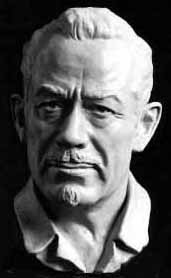 SALINAS
-- John Steinbeck's East of Eden was published for the
first time by Viking Press in September 1952, ten years before
the writer was awarded the Nobel Prize for Literature, and has
never been out of print since. In November 1952 East of Eden was
number one on the fiction best-seller list.
SALINAS
-- John Steinbeck's East of Eden was published for the
first time by Viking Press in September 1952, ten years before
the writer was awarded the Nobel Prize for Literature, and has
never been out of print since. In November 1952 East of Eden was
number one on the fiction best-seller list.
In
A Journal of a Novel: The East of Eden Letter, the writer's
diary of East of Eden, Steinbeck calls the novel “...the
story of my country and the story of me.” The book spans
the history of the nation from the Civil War to World War I and
tells the story of two American families, The Hamiltons, Steinbeck's
matenal relatives, are the “Universal Family” and the
fictional Trasks are the “Universal Neighbors.”
Steinbeck's
inspiration for the novel comes from the Bible, the fourth chapter
of the book of Genesis, verses one though sixteen, which recounts
the story of Cain and Abel. The title, East of Eden, was
chosen by Steinbeck from Genesis, Chapter 4, verse 16.
The
novel was originally addressed to Steinbeck's young sons, Thom
and John IV (then 6 1/2 and 4 1/2 respectively). Steinbeck wanted
to describe the Salinas Valley for them in detail: the sights,
sounds, smells, and colors.
Steinbeck
called East of Eden “a sort of autobiography of the
Salinas Valley.”
East
of Eden begins in 1862 and covers three generations and 56
years. The book ends in salinas, California, in 1918.
The
theme of East of Eden: “All novels, all poetry, are
built on the never-ending contest in ourselves of good and evil.”
Steinbeck
called this book “The big one as far as I'm concerned. Always
before I held something back for later. Nothing is held back here.”
East
of Eden is an allegorical/realistic novel, a daring combination
of biography and fiction.
Steinbeck
returned to Salinas in February of 1948 to begin intensive research
for what he considered would be his greatest book, East of
Eden. During his stay in Monterey, he drove to Salinas and
used the files of the local newspaper, the Salinas Index-Journal.
The novel was completed in November of 1951.
The
work on East of Eden followed two blows, the death of Edward
Ricketts, Steinbeck's best friend, known as “Doc” in
his Cannery Row books, and the separation and divorce from his
second wife, Gwyn.
Journal
of a Novel: The East of Eden Letters, the posthumously published
series of letters to Pascal Covici that accompanied the text of
East of Eden, was published in 1969.
The book
was written in part in New York City in a four-story brownstone
house on Seventy Second Street. Steinbeck had an upstairs room
for writing. The Steinbecks rented a Victorian two-story family
beach house in Siasconset on Nantucket Island where the writer
spent several months working on his novel.
Chapter 34
of the novel East of Eden was privately printed in 1952
with the title “What is the World's Story about?”
The novel
East of Eden has been translated into many languages of
the world, among them Burmese, Chinese, Danish, French, German,
Greek, Hungarian, Italian, Polish, Portuguese, Swedish, Japanese,
Norwegian, Serbo-Croatian, Slovene, and Spanish. Russian scholars
are working on the Russian translation.
The original
manuscript of East of Eden is in the Humanities Research
Center, University of Texas at Austin, Texas.
Steinbeck
kept track of things while writing East of Eden, and this
is the record:
•
Eleven years of mental gestation
•
One year of uninterrupted writing
•
25 dozen pencils
•
Approximately three dozen reams of paper
•
350,000 words (before cutting)
•
About 75,000 words in his work-in-progress journal
•
And
a rock-hard callus on the middle finger of the writer's right
hand.
Steinbeck's
widow, Elaine, in looking back on the year that he worked on the
book, said that his work on the novel affected him deeply. Perhaps
the best way to put it would be to say that it was the last stage
in putting himself back together after the years that had torn
him apart.
As Steinbeck
progressed through the early chapters, he noted that his voice
would be more apparent in this book than in any other because
he wanted it to contain everything he remembered to be true. He
would be in this one and not “for one moment pretend not
to be.”
Steinbeck
states about East of Eden, “It has everything in it
I have been able to learn about my craft or profession in all
these years.” He further claimed, “I think everything
else I have written has been, in a sense, practice for this.”
East of
Eden became a best seller so it was a natural for the movies.
East of Eden, the film, was directed and produced by Elia
Kazan and starred James Dean as “Cal.” The film opens
at approximately Chapter 37 in Part Four of the novel. The film,
shot in part in Salinas, California, was finished and released
in 1955. The film has now reached the stature of a classic.
-
East
of Eden was adapted for television and presented
on February 8, 9, and 11 in 1981 by ABC.
The Bantam
paperback edition became a multimillion copy best seller that
later scaled new heights on the strength of the James Dean movie
version.
The musical
version of East of Eden, “Here's Where I Belong,”
opened March 3, 1968, at the Billy Rose Theater and closed after
one showing.
East of
Eden, a new adaptation for the stage, was performed at Steinbeck
Festival XI and XV by The Western Stage Company of Hartnell College.





